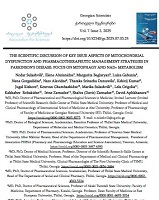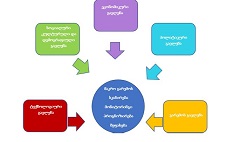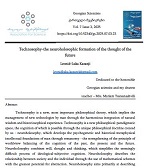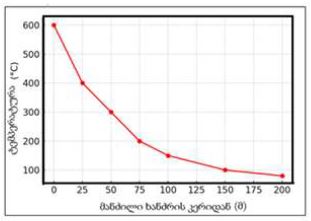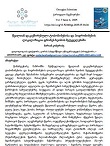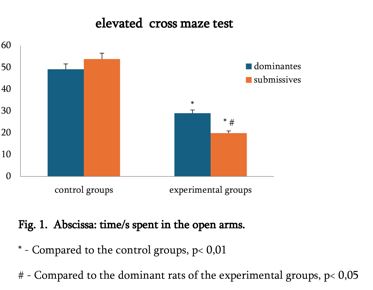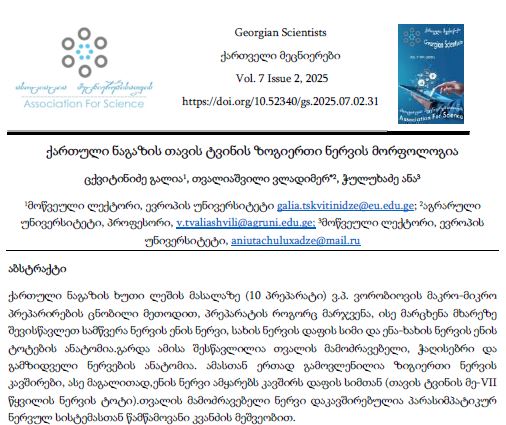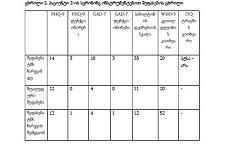Pharmacological potency of the different polarity fractions from the Rosa damascena Georgian cultivar oil waste aqueous extract
Загрузки
Дополнительные файлы
Damask rose (Rosa x damascena Herrm) is a well-known species within the genus Rosa L. cultivated in numerous countries due to its ornamental properties and especially for the valuable essential oil found in its flower petals. The latter has been utilized in perfumery, cosmetics, aromatherapy, and medicinal treatmentsfor centuries. Overall, the studies on R. damascena provide promising insights into its diverse effects and applications. However, it is important to note that further research is needed to validate these findings and fully understand the mechanisms underlying the observed effects. The present study aimed to assess the pharmacological features of the potency of the different polarity fractions RDF-H2O, RDF-50% and RDF-100% derived from the aqueous extract of rose oil waste from the R. damascena Georgian cultivar. In the carrageenan-induced acute inflammation model in rodents, it was established that all three fractions - RDF-H2O, RDF-50% and RDF-100% have an anti-inflammatory effect of higher-than-average strength. Among them, RDF-50% was significantly more active and, caused the 62.5% inhibition of the edema. A similar efficacy trend was revealed when evaluating the analgesic properties in mice in "Hot plate" model, but the most powerful analgesic effect was shown by fractions RDF-50% and RDF-100%, the maximum effect of which (86.0 and 99.7%, respectively) was observed 1 hour after administration. As a result of the experiment on the gastric ulcer model caused by absolute ethanol in rodents, it was revealed that the samples RDF-H2O and RDF-100% have a gastroprotective effect of medium strength (48 and 40%, respectively), whereas RDF-50% appeared less effective. The findings of current study highlight the potential of further investigation of the above-mentioned fractions to identify individual constituents responsible for the observed pharmacological effects.
Скачивания
Adinortey MB, Ansah C, Galyuon I, Nyarko A. (2013). In Vivo Models Used for Evaluation of Potential Antigastroduodenal Ulcer Agents. Ulcers.
Akram M, Riaz M, Munir N, et al. (2019) Chemical constituents, experimental and clinical pharmacology of Rosa damascena: a literature review. J Pharm Pharmacol. 2020 Feb;72(2):161-174. https://doi.org/10.1111/jphp.13185
Basim E, Basim H (2003) Antibacterial activity of Rosa damascena essential oil. Fitoterapia. 74(4), 394-6.
Baydar NG, Baydar H (2013) Phenolic compounds, antiradical activity and antioxidant capacity of oil-bearing rose (Rosa damascena Mill.) extracts. Ind Crops Products 41:375–380. https://doi.org/10.1016/j.indcrop.2012.04.045
Boskabady MH, Shafei MN, Saberi Z, Amini S. Pharmacological effects of rosa damascena. Iran J Basic Med Sci. 2011 Jul;14(4):295-307. . 499.
Dina E, Sklirou AD, Chatzigeorgiou S, et al. (2021). An enriched polyphenolic extract obtained from the by-product of Rosa damascena hydrodistillation activates antioxidant and proteostatic modules. Phytomedicine. 93:153757. https://doi.org/10.1016/j.phymed.2021.153757
Directive 2010/63/EU of the European Parliament and of the Council of 22 September 2010 on the protection of animals used for scientific purposes. Official Journal of the European Union. L 276/33-79
Dossi CG , González-Mañán D , Romero N et al (2018). Anti-oxidative and anti-inflammatory effects of Rosa Mosqueta oil supplementation in rat liver ischemia-reperfusion. Food Funct. 9(9): 4847-4857. https://doi.org/10.1039/c8fo00969d
Erbas S., Baydar H. (2016). Variation in scent compounds of oil bearing Rose (Rose damascena Mill.) produced by Headspace Solid Phase Microextraction, hydrodistillation and solvent extraction, Academy of Chemistry of Globe publications Rec. Nat. Prod. 10:5, 555-565.
Farooq A, Khan M, Riaz A., Ali A. (2011). Diversity of morphology and oil content of Rosa damascena landraces and related Rosa species from Pakistan. Pakistan Journal of Agricultural Sciences 48(3), 177-183.
Galal TM, Al-Yasi HM, Fawzy MA et al. Evaluation of the Phytochemical and Pharmacological Potential of Taif’s Rose (Rosa damascena Mill var. trigintipetala) for Possible Recycling of Pruning Wastes. Life. 2022; 12(2):273. https://doi.org/10.3390/life12020273
Hajhashemi,V, Ghannadi A, Hajilooa M (2010) Analgesic and Anti-inflammatory Effects of Rosa damascena Hydroalcoholic Extract and its Essential Oil in Animal Models. Iran J Pharm Res. 9(2): 163–168.
Homayoun M., Shafieian, R., Seghatoleslam M. et.al (2020). Protective impact of Rosa damascena against neural damage in a rat model of pentylenetetrazole (PTZ)-induced seizure. Avicenna Journal of Phytomedicine, 10, 574 - 583. https://doi.org/10.22038/AJP.2020.15621
Kalcheva-Karadzhova K, Shikov V, Mihalev K, et al. (2014) Enzyme-assisted extraction of polyphenols from rose (Rosa damascena Mill.) petals. Acta Univ Cib Ser E Food Technol 18(2):65–72. https://doi.org/10.2478/aucft-2014-0015
Kumar N, Singh B, Kaul V (2006) Flavonoids from Rosa damascena Mill. Natural Product Communications, 1(8); 623-626. https://doi.org/10.1177/1934578X0600100805
Labban L. and Thallaj N. (2020). The medicinal and pharmacological properties of Damascene Rose (Rosa damascena): A review. International Journal of Herbal Medicine 8(2), 33-37.
Latifi, G., Ghannadi, A., Minaiyan, M. (2015). Anti-inflammatory effect of volatile oil and hydroalcoholic extract of Rosa damascena Mill. on acetic acid-induced colitis in rats. Research in pharmaceutical sciences, 10(6), 514–522.
Mahboubi M. Rosa damascena as holy ancient herb with novel applications. Journal of Traditional and Complementary Medicine 6 (2016) 10-16 http://dx.doi.org/10.1016/j.jtcme.2015.09.005
McDonald JH. Handbook of Biological Statistics, 3rd ed. Baltimore, Sparky House Publishing. 2014.
Memariani Z. et al. (2015) Comparative analysis of phenolic compounds in two samples of Rosa damascena by HPLC. International Journal of Biosciences. 7(1), 112-118. http://dx.doi.org/10.12692/ijb/7.1.112-118
Morris C.J. (2003) Carrageenan-Induced Paw Edema in the Rat and Mouse. Methods in Molecular Biology, vol. 225: Inflammation Protocols 115-122.
Mulkijanyan K, Gogitidze N, Sulakvelidze M, et al. Pharmacological assessment of the aqueous extract of rose oil waste from Rosa x damascena Herrm cultivated in Georgia. World Journal of Biology Pharmacy and Health Sciences, 2021, 07(01), 001–008. https://doi.org/10.30574/wjbphs.2021.7.1.0069
Ng T.B., He J.S., Nius S.M., et al. (2004) A gallic acid derivate and polysaccharides with antioxidative activity from rose (Rosa rugosa) flowers. J Pharm Pharmacol 56(4):537–545. https://doi.org/10.1211/0022357022944
Olech M, Nowak R, Nowacka N, Pecio Ł, Oleszek W, Los R, Malm A, Rzymowska J (2015) Evaluation of rose roots, a post-harvest plantation residue as a source of phytochemicals with radical scavenging, cytotoxic, and antimicrobial activity. Ind Crops Prod 69:129–136. https://doi.org/10.1016/j.indcrop.2015.02.017
Ozkan G, Sagdic O, Baydar NG, Baydar H (2004) Antioxidant and anti-bacterial activities of R. damascena flower extracts. Food Sci Technol Int 10:277–281. https://doi.org/10.1177/1082013204045882
Parle M. et al. (2013) Laboratory models for screening analgesics. International Research Journal of Pharmacy, 4(1), 15-19.
Pavlov A, Popov S, Kovacheva E; Georgiev M, Ilieva M (2005). Volatile and polar compounds in R. damascena Mill 1803 cell suspension. , 118(1), 89–97. doi: 10.1016/j.jbiotec.2005.03.005
Rakhshandah H, Shakeri MT, Ghasemzadeh MR. (2007) Comparative Hypnotic Effect of Rosa damascena Fractions and Diazepam in Mice. Iranian Journal of Pharmaceutical Research, 6 (3): 193-197. https://dx.doi.org/10.22037/ijpr.2010.721
Rezvani-Kamran, A., Salehi, I., Shahidi, S. et al. (2017). Effects of the hydroalcoholic extract of Rosa damascena on learning and memory in male rats consuming a high-fat diet. Pharmaceutical Biology, 55, 2065 - 2073. https://doi.org/10.1080/13880209.2017.1362010
Sabahi Z. et al (2020), Valorization of Waste Water of Rosa damascena Oil Distillation Process by Ion Exchange Chromatography. The Scientific World Journal, vol. 2020, Article ID 5409493, 6 pg. https://doi.org/10.1155/2020/5409493
Slavov A., Vasileva I., Stefanov L. et al. (2017). Valorization of wastes from the rose oil industry. Rev Environ Sci Biotechnol 16, 309–325. https://doi.org/10.1007/s11157-017-9430-5
The Plant List (TPL) http://www.theplantlist.org/
Wen-ya Liu, Lin-yu Chen, Ying-ying Huang et al. (2020) Antioxidation and active constituents analysis of flower residue of Rosa damascena. Chinese Herbal Medicines, 12(3), 336-341. https://doi.org/10.1016/j.chmed.2020.05.005
World Flora Online (WFO) http://www.worldfloraonline.org/
Yousefi B., Jaimand K. (2018) Chemical Variation in the Essential Oil of Iranian Rosa damascena Landraces under Semi-arid and Cool Conditions. International Journal of Horticultural Science and Technology 5(1); 81-92. https://doi.org/10.22059/ijhst.2018.256329.234
Copyright (c) 2023 GEORGIAN SCIENTISTS

Это произведение доступно по лицензии Creative Commons «Attribution-NonCommercial-NoDerivatives» («Атрибуция — Некоммерческое использование — Без производных произведений») 4.0 Всемирная.

















